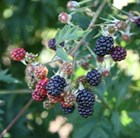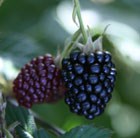Blackberry plants at Crocus
by Diane - July 11th, 2012.Filed under: Crocus.
Easy to grow, plenty of fruit and you’ll love growing your own. Turn the fruit into jam or pies!
Thornless are less troublesome having no thorns to worry about. Everyone should grow some fruit at home.

blackberry ‘Oregon Thornless’ (blackberry) £12.99
Position: full sun or partial shade Soil: any soil Rate of growth: fast-growing Other features: medium-sized, juicy fruit (late August to late September) Hardiness: fully hardy A popular variety with ornamental leaves and thornless stems. The saucer-shaped, white flowers flushed with pink are produced in summer, followed by medium-sized fruit with a mild and juicy flavour in late August to late September. It is a good variety to grow where people are likely to brush past the stems or trained over an arch or trellis. Garden care: Prepare the ground well before planting. Remove all weeds and dig in plenty of well-rotted manure. Allow 3m between each plant and 1.8m between rows. Once planted, shorten the canes to about 23cm (9in). Each spring, mulch well with well-rotted manure. Plants flower on one-year-old wood, so the new canes need to be separated from fruiting ones. After cropping, cut the fruiting canes down to the ground and tie in the new ones that have grown that year.

blackberry ‘Apache’ (blackberry) £9.99
Position: full sun or partial shade Soil: any soil Rate of growth: fast-growing Other features: Extremely large sized, juicy fruit (late August to late September) Hardiness: fully hardy Apache is an excellent variety for the home gardener. It produces really big fruit that have a very sweet flavour, on erect, thornless canes. Bred at the University of Arkansas, each fruit will weigh around 7-10g each. They are produced mid-season and will keep well after being picked. Garden care: Prepare the ground well before planting. Remove all weeds and dig in plenty of well-rotted manure. Allow 2m between each plant and 2m between rows. Each spring, mulch well with well-rotted manure. Plants flower on one-year-old wood, so the new canes need to be separated from fruiting ones. After cropping, cut the fruiting canes down to the ground and tie in the new ones that have grown that year.

blackberry ‘Loch Ness’ (blackberry) £9.99
Position: full sun or partial shade Soil: any soil Rate of growth: fast-growing Other features: medium-sized, juicy fruit from mid August Hardiness: fully hardy This high yielding, thornless bush can produce up to 3.6kg of large, firm and glossy blackberries from mid August until the first frosts. It is such a super-producer, that it is now the number one variety used by commercial growers. Grow it in a large pot on a sunny patio, or train it against a sunny wall or fence and enjoy a long-lasting supply of delicious fruit. Garden care: Prepare the ground well before planting. Remove all weeds and dig in plenty of well-rotted manure. Space at 1.8m intervals and once planted, shorten the canes to about 23cm (9in). Each spring, mulch well with well-rotted manure. Plants flower on one-year-old wood, so the new canes need to be separated from fruiting ones. After cropping, cut the fruiting canes down to the ground and tie in the new ones that have grown that year.

blackberry ‘Reuben’ (primocane blackberry) £7.99
Position: full sun or partial shade Soil: any soil Rate of growth: fast-growing Other features: deliciously sweet and juicy fruit (late July to the end of August) Hardiness: fully hardy Bred at the University of Arkansas, Reuben has been heralded as the first primocane blackberry – ie. it produces fruit on the current years growth. Not only that, but the fruits, which are produced in abundance, are the size of a plum (weighing up to 9g each). They have a glossy skin and sweet, slightly fruity-flavoured flesh and can be eaten straight from the bush, or used to make jams, pies or coulis. Garden care: Prepare the ground well before planting. Remove all weeds and dig in plenty of well-rotted manure and then plant at 2m intervals. Each spring, mulch well with well-rotted manure. Cut back all the canes to just above ground level in late winter or early spring each year. As soon as the new growth starts to emerge, you should start feeding them with a good fertiliser and begin spraying for pests and diseases if necessary. When the canes have reached 1m tall, ‘soft-tip’ them by removing the top 2 to 5cm of growth. This will encourage the stems to branch and therefore increase the yield. Ideally this ‘soft-tipping’ should be done before the flower buds are produced as removing the flowers will delay the crop and reduce the yield. To grow as a primocane (ie producing two, smaller crops each year), cut back the new spring stems, which have produced fruit at their tips in autumn, to a point just below where the blackberries were produced, soon after they have finished cropping. These half-canes can then be left to overwinter, will put on new top growth in spring and will then go on to produce the first crop of berries in early summer. After these two year old canes have finished fruiting they should be cut right back to their base. In the meantime, new canes will have emerged from the base of the plant in spring and these should be tied onto their support as they grow. These new canes will then produce the second, later crop and should have their tops lopped off after fruiting. This then creates a repeating cycle.

blackberry ‘Ouachita’ (blackberry) £6.99
Position: full sun or partial shade Soil: any soil Rate of growth: fast-growing Other features: deliciously sweet and juicy fruit (late July to the end of August) Hardiness: fully hardy On upright, near-thornless stems, sweet, generously-sized fruits (each weighing up to 7g), are produced in large numbers during the early part of the picking season. This is a recently introduced cultivar, which has been developed by the University of Arkansas, and trials have shown it is comparable to many of the long-standing favourites for taste, reliability and shelf-life after picking. Garden care: Prepare the ground well before planting. Remove all weeds and dig in plenty of well-rotted manure and then plant at 2m intervals. Each spring, mulch well with well-rotted manure. Plants flower on one-year-old wood, so the new canes need to be separated from fruiting ones. After cropping, cut the fruiting canes down to the ground and tie in the new ones that have grown that year.

blackberry ‘Loch Tay’ (blackberry) £6.99
Position: full sun or partial shade Soil: any soil Rate of growth: fast-growing Other features: deliciously sweet and juicy fruit (late July to the end of August) Hardiness: fully hardy Bred at the Scottish Crop Research Institute, ‘Loch Tay’ produces an earlier, sweeter crop than ‘Loch Ness’. The canes are thornless and semi-erect, so will need minimal support, and they produce a crop of medium-sized berries from late July down south and in warm, sheltered gardens, or mid August in more exposed locations. Garden care: Prepare the ground well before planting. Remove all weeds and dig in plenty of well-rotted manure and then plant at 2m intervals. Each spring, mulch well with well-rotted manure. Plants flower on one-year-old wood, so the new canes need to be separated from fruiting ones. After cropping, cut the fruiting canes down to the ground and tie in the new ones that have grown that year.






